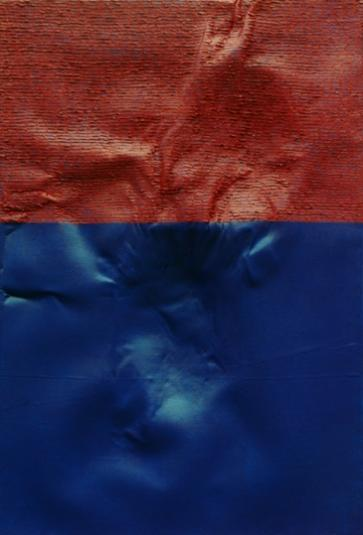Squirming
165x172cm 综合材料
2019年
画布作为一种平面媒材,已经辉煌地写下了400多年的历史,艺术家不断在二维的平面上尝试各种创新,企图创造一种新的空间概念,而15世纪文艺复兴时期的透视法,使画面有了景深,暂时满足了艺术家在二维画布上营造空间感的饥渴,例如米开朗基罗在西斯汀教堂的壁画,画面融入了繁复的建筑元素,凸显了人物在空间里的立体感;而此后的几百年中,学院派主掌了艺术史的书写,强调主题的教化功能和道德感,追求形式和内容的崇高性,不再一味探索画面中的空间感,直到20世纪初的立体派,毕卡索试图以另一种全观的视角,打破物象的基本结构,让支离破碎的画面营造出一种解构后再重造的内透感,而紧接着的拼贴技法,又让画面产生一种外放感。这一凹一凸、一缩一放的画面实验,在当时并没引起太多的关注和讨论,但在二次大战后却引发了另一场美学革命。美国抽象表现主义在战后独领风骚,其中以罗斯科为首的色域绘画,将色彩作为一种时间概念,企图在对比或互补的色块交融中,寻找一种精神层面的空间感,且在这空间里塑造最大的时间效应。后来意大利艺术家卢奇欧·封塔纳又将这时空观念进一步引申,以割破平面画布来制造三维的空间,然画布上单彩的背景色,更是记忆的另一种呈现,记忆不外是一种时间概念,当时间发酵覆盖了整件作品,便逐步将之升华为四维的创作。几百年来,艺术家在画布上的实验,每每在艺术史上留下了印记,寻着前辈的足迹,在反叛与继承中,艺术家一味追求的,不外是在平面画布上所展现的时间和空间概念。而王小松的创作在《破界》系列之始,便已展开了一连串时间和空间的实验。
Canvas, as a kind of planar media, has brilliantly reigned over 400 years of art history. Artists have been consistently making various innovations on the two-dimensional picture plane, attempting to create a new concept of space. Renaissance perspective in the 15th century provided the picture with depth of vision, temporarily quenching the thirst of building space on the plane of canvas, as was illustrated by Michelangelo's fresco in the Sistine Chapel which integrated complex architectural elements into the pictures, highlighting the three-dimensionality of the figures in space. In the following several hundred years, the academic art dominated the art history, emphasizing the ethical and moral functions of art, pursuing the loftiness of form and content, and ceasing the exploration of space on canvas. Until the emerging of Cubism in the early 20th century, Picasso started to take a different perspective by breaking the basic structure of the images. The multifaceted picture created an inward perspective after deconstruction, while the following collage technique gave the picture an outward release. This picture experiment of concave and convex, contraction and expansion did not raise too much attention and discussion at that time, however, it triggered another aesthetic revolution after the World War II. American Abstract Expressionism became a dominant trend after the war, among which the Color Field headed by Rothko applied colors to represent the concept of time. With the juxtaposition of large area of melting colors, he tried to seek a spiritual space, in which to construct a maximum volume of time effect. Later, the Italian artist Fontana further developed this concept of time and space by cutting a picture plane to create a three-dimensional space. However, the monochromatic color background on the canvas is a representation of memory, which is nothing more than a concept of time. When the fermentation of time covered the whole work, it gradually evolved into a four-dimensional creation. For hundreds of years, artists' experiments on canvas have left trails on the history of art. By following the footsteps of their predecessors and through succession and rebellion, artists have been persistently pursuing the concept of time and space displayed on the plane of the picture. Since the beginning of Boundary Breaking series, Wang Xiaosong has been starting the exploration on time and space.
《破界》里的首张作品《床》,用红蓝两色把画布一分为二,蓝色往上推移,让红色显得窘迫,艺术家利用色彩制造了界限,但又利用画布上的皱褶打破了红蓝的界限,让空间得以在色彩里延伸出来,藉此寓意留在床上的躯体和温度,巧妙勾勒出了记忆中的时间概念。
The picture of Bed, the first work of Boundary Breaking series, is divided by red and blue. The red seems embarrassed as the blue pushing up. With colors the artist sets a boundary, yet with wrinkles he breaks this boundary and releases the space through colors, to represent the earlier body and its warmth left behind and, at the same time, skillfully sketch out the time in memory.

王小松 床
bed
100×150cm 油画
2013年
而2015年的《舞姿》,更把画布形塑成阶梯,让足迹深深地崁入蓝色的阶梯上,随着扭动且带着韵律的足迹,幻化为美妙的舞姿!有了《舞姿》的大胆尝试,王小松手里的画布开始有了更大胆的翻转,几乎皱成一团纠结成块的画布,成了一幅幅《无题》的雕塑绘画,平面被打破了,三维于焉形成,而单色彩的张力更唤醒了观者的过往记忆,时间跃然画布上,穿梭在崎岖不平的空间里,诉说着道不尽的过去、现在与未来!
In Dancing of 2015, the canvas was shaped into a staircase, with footprints embedded deep in the blue steps. The rhythmically twisted footprints were transformed into a graceful dance! With the bold try of Dancing, Wang Xiaosong launched an even bolder revolution, the canvases crumpled into virtually tangled clumps became a series of Untitled sculpture paintings. The plane was broken and three-dimensionality came into being. The tension of the monochromatic color scheme awakes the viewers' memories, time leaping on the canvas, shuttling in the rugged space, talking about their endless past, present and future!

王小松 舞姿1
Dance 1
150×100cm 综合材料
2015年
而2020年的作品,在皱折的画布上更发生了色彩的变化,让原本单色彩的张力瞬间转化为一股强大的凝聚力,不仅是画龙点睛制造新意,更紧紧抓住了观者的视线,让人思索着破坏重构后的新语境。其中《向罗斯科致敬》,让金属靛蓝和橘红透过皱褶交融,在三维空间中让色彩产生对话,透过对话直接联系了时间,但时间不因空间而存在,因为在创造空间的过程中,时间早已悄然形成,只是透过了色彩,让时间的流逝跃然画布上,这点恐怕连罗斯科都望其项背。
His works of 2020, brought color changes on the crumpled canvas, transforming instantly the original single-color tension into a powerful cohesive force, which does not only make something new by a wonderful finishing touch, but also attracts the viewers' attention and encourages them to think about the new context born in the deconstruction. In respect to Rothko, the metal indigo blue and orange blend through wrinkles, and colors converse in a three-dimensional space. In the conversation time is straightly involved, but time does not exist because of space, since in the process of space creation, time has already come into being. But only through colors, the passing of time could leap onto the canvas, which I am afraid even Rothko is falling far behind.

王小松 向罗斯科致敬